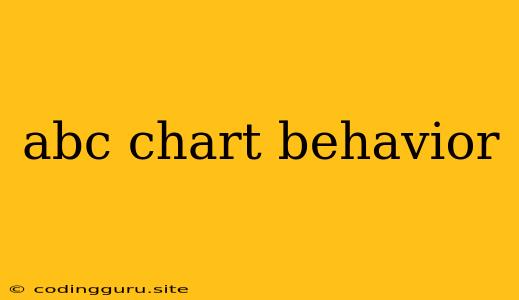Understanding ABC Analysis: A Powerful Tool for Charting and Analyzing Behavior
Have you ever felt overwhelmed by the sheer volume of data you need to analyze? Do you struggle to prioritize your efforts when faced with numerous variables influencing behavior? This is where the ABC chart comes in handy. It's a simple yet powerful tool that can help you understand and manage behavior, particularly in situations where it's challenging to grasp the complex interplay of antecedents, behaviors, and consequences.
What is an ABC Chart?
The ABC chart is a behavior analysis tool used to systematically record and analyze the relationship between antecedents, behaviors, and consequences. It serves as a framework for understanding why a particular behavior occurs and how to effectively intervene or modify it.
Understanding the Components of an ABC Chart:
- Antecedents: These are the events, situations, or stimuli that occur before the behavior. They act as triggers, setting the stage for the behavior to occur. Examples include:
- Environmental factors: Loud noises, crowded environments, specific locations.
- Internal factors: Hunger, thirst, fatigue, emotional states.
- Social cues: Requests, instructions, verbal interactions.
- Behaviors: These are the specific actions or responses that are being observed and analyzed. It's crucial to define the behavior clearly and objectively. Examples include:
- Verbal behaviors: Yelling, whining, complaining.
- Physical behaviors: Hitting, kicking, throwing objects.
- Nonverbal behaviors: Facial expressions, body language.
- Consequences: These are the events, situations, or outcomes that follow the behavior. They can be reinforcing (increasing the likelihood of the behavior occurring again) or punishing (decreasing the likelihood of the behavior occurring again). Examples include:
- Positive reinforcement: Receiving praise, getting a reward, escaping an unpleasant situation.
- Negative reinforcement: Avoiding an unpleasant task, receiving attention.
- Punishment: Time out, loss of privileges, verbal reprimand.
How to Use an ABC Chart:
- Identify the Target Behavior: Clearly define the specific behavior you want to analyze and modify.
- Create a Chart: Design a chart with columns for Antecedents, Behaviors, and Consequences.
- Record Observations: Observe the target behavior and note the antecedents, behaviors, and consequences that occur in each instance. Be as specific and detailed as possible.
- Analyze the Data: Once you have collected enough data, analyze the patterns and relationships between the columns. This helps you understand the triggers, the behavior itself, and the factors that influence its occurrence and persistence.
- Develop Interventions: Based on your analysis, formulate strategies and interventions to modify the behavior. This could involve changing the antecedents, reinforcing desired behaviors, or modifying the consequences.
Example of an ABC Chart:
Imagine a child who throws tantrums when they are denied access to their favorite toy.
| Antecedent | Behavior | Consequence |
|---|---|---|
| Child asks for toy, parent refuses | Child throws a tantrum (screaming, crying, hitting) | Parent gives the toy to stop the tantrum |
In this scenario, the antecedent is the parent refusing the toy, the behavior is the tantrum, and the consequence is receiving the toy. The parent, by giving in to the tantrum, unintentionally reinforces the behavior, making it more likely to occur again in the future.
Tips for Effective ABC Charting:
- Consistency: Regularly record observations to ensure you capture a representative sample of behavior.
- Specificity: Use precise language to describe the antecedents, behaviors, and consequences.
- Objectivity: Focus on observable actions and avoid making subjective interpretations.
- Collaboration: Involve other individuals who interact with the target individual for more comprehensive data.
Conclusion:
The ABC chart is a valuable tool for understanding and managing behavior. By systematically analyzing the antecedents, behaviors, and consequences, you can identify patterns, develop effective interventions, and ultimately promote positive change. Its simplicity makes it readily applicable across various settings, including homes, schools, workplaces, and clinical settings. Remember, the key to success lies in understanding the intricate relationships between these three elements and utilizing this knowledge to create a positive and supportive environment for all involved.
